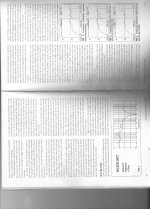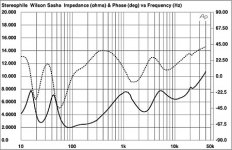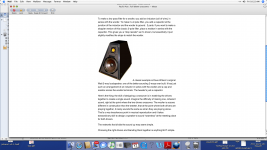A common confusion, you do not need a hard ride to get good grip. In fact a softly suspended car will often handle better. Audi's are hard as rock because drivers think that means sporty. Also meat sacks are poor at handling body roll.
Better road handling means to minimize all unsprung mass. Soft handling requires less favourable ratio between sprung and unsprung mass. There is a reason why excellent road handling almost always couples to hard rides.
In an F1, the unsprung mass is absolutely minimized and boy are they hard!
However, it seems that in some hi-end modern cars feedback/feedforward techniques with actuated dampers can create relatively soft rides with good handling - it basically is a control system engineering problem.
Jan
Better road handling means to minimize all unsprung mass. Soft handling requires less favourable ratio between sprung and unsprung mass. There is a reason why excellent road handling almost always couples to hard rides.
In an F1, the unsprung mass is absolutely minimized and boy are they hard!
However, it seems that in some hi-end modern cars feedback/feedforward techniques with actuated dampers can create relatively soft rides with good handling - it basically is a control system engineering problem.
Jan
Pushrod suspension can deal with most of the unsprung mass issues...
I had a demo ride in a Jaguar with active roll control in 1988. Nothing modern about it at all. In F1 the suspension stiffness is due to Aero considerations as much as anything. Shame the valves for full active will never get below 20k a corner.
The job of the suspension is to keep the tyre in contact with the road. Stiff suspension is not actually that good at this unless the road is very smooth.
When I was into silly little kit cars it was found that Anti-roll bars generally didn't help much. But we are talking sub 750kg toys here.
A common confusion, you do not need a hard ride to get good grip. In fact a softly suspended car will often handle better. Audi's are hard as rock because drivers think that means sporty. Also meat sacks are poor at handling body roll.
Disagreed. On the other hand, it's hardly a linear function, as you can have a car with a relatively firm ride but still with only so-so road holding, just as you can have a car hich is on the firm side and has very good road holding, yet is not uncomfortable (e.g. my present car, a Chevrolet Cruze, with an European setup, a bit different from the US setup).
Crazy thought: how about fixing the driver or choosing a better one? I know, crazy, what in the world could I be thinking.
Not at all crazy, in my view most accidents happen because the current driver overrates his own prowess.
When I put together my own version of the Yugo, it ould do unbelievable things, BUT a plank for a seat would be more comfortable and it took me months of hard practice and two sets of tyers to get it to do what it could. That's a factor all but forgotten these days of electronics, in the end it's the driver who's the bottleneck And of all the electronics, all it has is a very precise thermal control of the engine, keeping its operating temp between 92 and 94 deg centigrade (factory spec for regular version). Not even the ABS beside it.
Better road handling means to minimize all unsprung mass. Soft handling requires less favourable ratio between sprung and unsprung mass. There is a reason why excellent road handling almost always couples to hard rides.
In an F1, the unsprung mass is absolutely minimized and boy are they hard!
However, it seems that in some hi-end modern cars feedback/feedforward techniques with actuated dampers can create relatively soft rides with good handling - it basically is a control system engineering problem.
Jan
Plus a few other things as well, but fail with unsprung mass and you failed it all.
Disagreed. On the other hand, it's hardly a linear function, as you can have a car with a relatively firm ride but still with only so-so road holding, just as you can have a car hich is on the firm side and has very good road holding, yet is not uncomfortable (e.g. my present car, a Chevrolet Cruze, with an European setup, a bit different from the US setup).
To do a shock absorber properly you need to have 5-way adjustability in the valving. Oddly this costs so most OEM shocks are a compromise to good enough. Most road cars are a compromise to keep costs and law suits down.
Pushrod suspension can deal with most of the unsprung mass issues...
I had a demo ride in a Jaguar with active roll control in 1988. Nothing modern about it at all. In F1 the suspension stiffness is due to Aero considerations as much as anything. Shame the valves for full active will never get below 20k a corner.
The job of the suspension is to keep the tyre in contact with the road. Stiff suspension is not actually that good at this unless the road is very smooth.
When I was into silly little kit cars it was found that Anti-roll bars generally didn't help much. But we are talking sub 750kg toys here.
750 kg jobs can be anything but toys. Remember the Cosworth Escort? That was below 750 kg with Coswort's 1.6 litre engine (115 hp for the road legal version, 160 hp for the rally version and 180 hp for the speed racers), Rneual Apline (160 hp 1.6 litre) actually ended up at 580 kg and the Alpnine team had to *** weight to get it the normm specified at 600 kg minimum, to name just two.
Colin Chapman was right, it's perhaps not all but a lot is in the weight to power ratio. As amply demonstrated by Lotus, Mini, Escort, Simca, et al. Add a good gearbox inside and you will have a true pocket rocket.
dvd and Mooly.
The schematic of Kenwood Basic M1 is at HiFi Engine - Owners and Service Manuals
Thanks George, I might take a look at that.
Colin Chapman was right, it's perhaps not all but a lot is in the weight to power ratio. As amply demonstrated by Lotus, Mini, Escort, Simca, et al. Add a good gearbox inside and you will have a true pocket rocket.
You forgot the Lotus7 , which was my silly toy
I'm older now so prefer cars where I can use all of the power, all of the time. Bit like having a power amp where you are 1dB below clipping when you crank it up.
Unless you have SY's red light amp, where you probably clip it now and again for the light show
I have never heard any Wilsons, but I am surprised at the response and in JA's suggestion that an equalizer could improve the bottom end on IIRC a 6 or 7 thousand $ pair of speakers. I can think of many speakers in that price range with exemplary response and wonderful imaging that would not require a sub or an equalizer.
I heard watt/puppy and WHOW sub at a hifi show 1994 ish. Very impressive, but Dave Wilson is a master at conditioning the audience. Dunno how much was the pre-talk messing with my head, but he played a choral recording where the choir did seem to be 30 ft behind the rear wall of the room.
Couldn't afford it them, can't afford it now
Couldn't afford it them, can't afford it now
Not at all crazy, in my view most accidents happen because the current driver overrates his own prowess.
My speakers have never had an accident, though my dog once tried blaming a puddle on them.
And how is that a good idea, Bill?
What a good idea?
Well at least we are talking about audio electronics again. '-)
As a designer of amplifiers, I cannot dictate to the customer what loudspeaker or combination of loudspeakers they might use, so I have to design for 'reasonable worst case'. I think that many here forget that, because 'their' loudspeaker load is a relatively easy drive. I too have such speakers in service, daily, but I still have to drive the difficult speakers as well.
Back around the late 1980's, I was given a set of WATT-Puppy 1 loudspeakers to replace my Rogers with a subwoofer. I therefore was GIVEN this difficult load to drive with what I had available. I wasn't working for Parasound then so I made do with an Electrocompaniet. It worked OK. Now WHY did it work OK?
Because it did NOT have a sophisticated E-I amp protection network that might have fired regularly and upset the sound. Just good luck to use that amp, I guess.
Now where did the problem with the WATT1 come from? There apparently is a series resonant circuit connected between the tweeter and ground that omitted sufficient R to keep from looking like a virtual short circuit at 2KHz. This was a design mistake, made by Dave Wilson, who looked at the measurements of the actual acoustic output, and not the impedance, and he used Krell amps that could drive this difficult load successfully. Had he tried a Japanese amp similar to what you guys seem to like, he would have known something was wrong. I have told Dave this, so he knows. No designer is perfect, but I personally found that the WATT was one of the best sounding speakers in the world, bar none, because Dave put a great deal of care into the design, especially the construction of the speaker cabinet.
Today, I use a Wilson SASHA, and while it is bigger, stronger, and more impressive, I still fondly remember the WATT1. Here is the comparison between the WATT1 and the SASHA impedance curves. Still a difficult drive.
As a designer of amplifiers, I cannot dictate to the customer what loudspeaker or combination of loudspeakers they might use, so I have to design for 'reasonable worst case'. I think that many here forget that, because 'their' loudspeaker load is a relatively easy drive. I too have such speakers in service, daily, but I still have to drive the difficult speakers as well.
Back around the late 1980's, I was given a set of WATT-Puppy 1 loudspeakers to replace my Rogers with a subwoofer. I therefore was GIVEN this difficult load to drive with what I had available. I wasn't working for Parasound then so I made do with an Electrocompaniet. It worked OK. Now WHY did it work OK?
Because it did NOT have a sophisticated E-I amp protection network that might have fired regularly and upset the sound. Just good luck to use that amp, I guess.
Now where did the problem with the WATT1 come from? There apparently is a series resonant circuit connected between the tweeter and ground that omitted sufficient R to keep from looking like a virtual short circuit at 2KHz. This was a design mistake, made by Dave Wilson, who looked at the measurements of the actual acoustic output, and not the impedance, and he used Krell amps that could drive this difficult load successfully. Had he tried a Japanese amp similar to what you guys seem to like, he would have known something was wrong. I have told Dave this, so he knows. No designer is perfect, but I personally found that the WATT was one of the best sounding speakers in the world, bar none, because Dave put a great deal of care into the design, especially the construction of the speaker cabinet.
Today, I use a Wilson SASHA, and while it is bigger, stronger, and more impressive, I still fondly remember the WATT1. Here is the comparison between the WATT1 and the SASHA impedance curves. Still a difficult drive.
Attachments
Last edited:
I was on our Formula-SAE team during undergrad, namely suspension and rear differential packaging team, as packaging everything becomes as big a deal as the actual geometry at some point.
Given the autocross focus and (at the time) lack of aerodynamics, we aimed for big pushrod ratios to get more working distance on our dampers (modified dirt bike shocks, at least then) and a pretty soft suspension to keep the tires on the ground. Tuning done via ARB, but not much. Also the tires are very compliant.
On the flipside, go karts (for race tracks at least) forgo traditional suspensions, although those chassis are designed to flex accordingly, at least as best they can. Speaking of getting the kilograms down.
Enough digressing this analogy, other than to say it's like everything else--you've got to do your homework and design/engineer appropriately.
Given the autocross focus and (at the time) lack of aerodynamics, we aimed for big pushrod ratios to get more working distance on our dampers (modified dirt bike shocks, at least then) and a pretty soft suspension to keep the tires on the ground. Tuning done via ARB, but not much. Also the tires are very compliant.
On the flipside, go karts (for race tracks at least) forgo traditional suspensions, although those chassis are designed to flex accordingly, at least as best they can. Speaking of getting the kilograms down.
Enough digressing this analogy, other than to say it's like everything else--you've got to do your homework and design/engineer appropriately.
What a good idea?
Driving your say 100W amp normally at 80W because now you want to have all the power all the time. That leaves you prescious litttle headroom, 1 dB is next to nothing. One transient and you could be in trouble.
Ditto for cars. I would never want to drive my car engine at 80% of full power over longer periods of time. Unless it has been modified, it will overheat soon enough. Rather, I do like lots of power, but not as a race factor, rather as a factor of driving comfort since I cn use an easy pace, eventually even making an automatic gear shifter superfluous simply because your engine has enough power to pull you through all around the place in third gear. And still have enough left over for some fire and brimstone if need be.
A DAC has a fixed max output so for a given gain you KNOW exactly how large the transient is. I do not need 300W in reserve for something I know will not come. Playing vinyl you still have that guessing game. Anyway normal is 1W with my speakers in my room at my preferred level.Driving your say 100W amp normally at 80W because now you want to have all the power all the time. That leaves you prescious litttle headroom, 1 dB is next to nothing. One transient and you could be in trouble.
You completely misunderstood. Many performance cars will hit 60mph (100kmh) in second gear and 100mph in 3rd. What do you do then? Very impressive on the slip road, but no real fun. OTOH a low geared car without vast excesses of power that you actually DRIVE rather than point is a lot of fun. Motorbike engines in 500kg Lotus 7 replicas are particularly fun. fast as anything up to about 120 then the aerodynamics hit you. Power band starting around 6000RPM and going up to silly. 3 shifts to hit 60. No power steering, no ABS, no airbags, no roof. But you arrive having enjoyed the journey.Ditto for cars. I would never want to drive my car engine at 80% of full power over longer periods of time. Unless it has been modified, it will overheat soon enough. Rather, I do like lots of power, but not as a race factor, rather as a factor of driving comfort since I cn use an easy pace, eventually even making an automatic gear shifter superfluous simply because your engine has enough power to pull you through all around the place in third gear. And still have enough left over for some fire and brimstone if need be.
- Status
- Not open for further replies.
- Home
- Member Areas
- The Lounge
- John Curl's Blowtorch preamplifier part II


